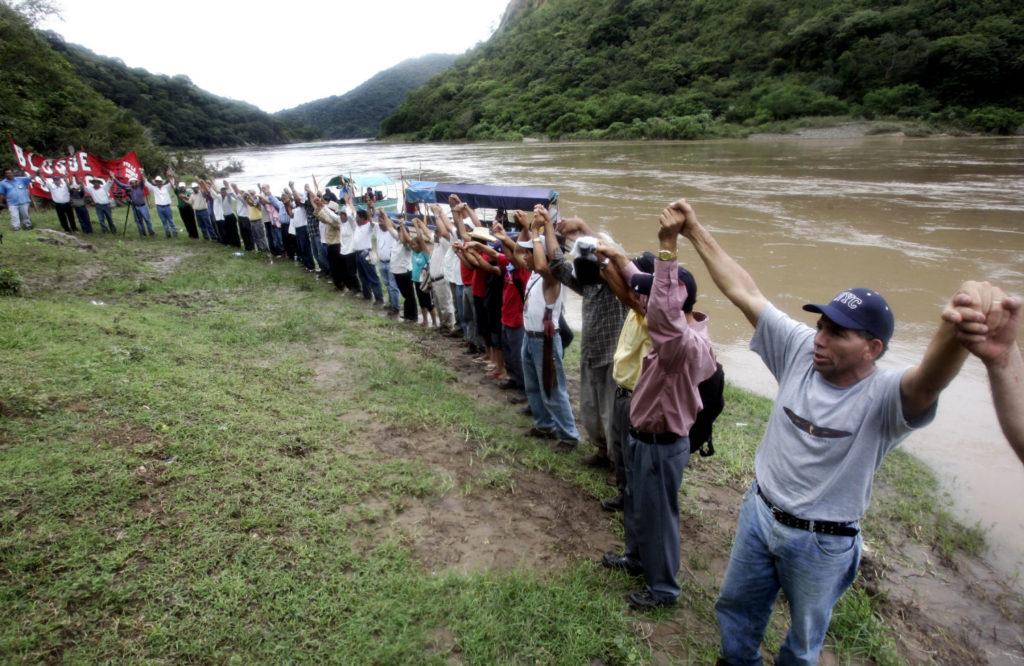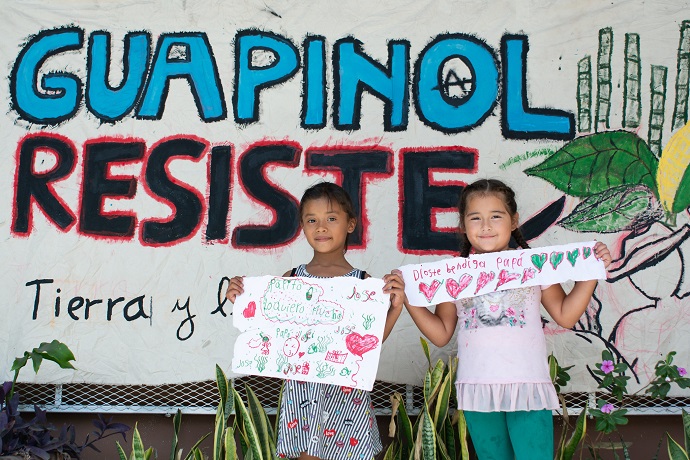
I saw waters flowing from the temple, from the right side. And all to whom those waters came were saved, and they shall shout, “Hallelujah.” (Old Latin hymn, based on Hebrew Scripture).
by Jim Phillips
Water is a most precious and essential necessity of human life. Its availability is synonymous with life itself. This reality is starkly apparent to some folks, angels of mercy, U.S. citizens who place water and other necessities in the desert along the U.S.-Mexican border for immigrants to use so that they will not die crossing to the United States to seek a decent and dignified life and to flee violence, poverty, and political corruption in their Central American homes. For this work of mercy, people are arrested by U.S. border authorities and charged with aiding “criminal” acts, the acts of people entering United States territory without proper papers. The water-bearing angels of mercy and the migrants from Central America are criminalized. Some are sent to prison. Some of the “illegal aliens” who now cross into the U.S. without the help left by the angels of mercy will probably die in the desert (many do every year). U.S. enforcement personnel empty containers of water into the desert soil rather than allow “illegal aliens” to drink. Apparently, this is not a crime, but rather a way to uphold the “law.” One might wonder why or how acts of mercy have become crimes. Defending the rivers of the planet—the sources of water for most of humanity— has also become a crime, one that can carry a death sentence in many parts of the world.
Like our sisters and brothers in the United States and Canada, Native people across Mexico, Central America and South America are leading efforts to protect Mother Earth. Dam-building projects, mining, logging, and other extractive industries are promoted by governments and private industries at the expense of Indigenous people and their land and water. In many Latin American countries, Indigenous communities are recognized as the first line of defense for the environment and the Earth. This work often requires great sacrifice. Many die in the struggle, while others are jailed for protecting the rivers, the forests, and the land. “Environmental activist” does not capture the stark reality of defending Mother Earth. Many in Central America prefer “environmental defender.”
The Lenca people are the largest Indigenous community in Honduras, about 300,000. In 2013, the Lenca found themselves confronting their own Honduran government and a foreign company that planned to build a dam across the Gualcarque, a river that the Lenca call sacred, where the spirits of the ancestors and the descendants yet to be born dwell. The dam-building company’s guards told the people they could no longer use the river. International laws and legal agreements require governments and companies to provide full and truthful information to local Indigenous communities and to ask for the people’s consent before beginning any dam, mining, or logging project that might affect local Indigenous people. But neither the government nor the company consulted the affected Lenca communities. Community leaders saw this failure in the context of their 500 years of fighting colonialism.
 Berta Cáceres was a dynamic Lenca community leader and cofounder of the grassroots organization, COPINH, the Civic Council for Popular and Indigenous Organizations of Honduras. COPINH began a struggle to stop the dam from being built. From April to September, 2013, Lenca people kept guard at a roadblock they had constructed on the road that the company had bulldozed over Lenca land to the river. The people also walked in procession almost daily along the road to the compound by the river where the dam was to be built. These walks became a combination of sacred procession, with incense and prayers, and protest march. They were often joined by national and international human rights and environmental defenders offering solidarity. When they arrived at the company compound, the Lenca and their visitors would stand before the front gate in vigil for a while before returning home. A Honduran Army unit was deployed at the compound to “defend” the place against the Lenca, despite the peaceful nature of the protests. On July 15, 2013, a soldier shot and killed Lenca COPINH member Tomás Garcia and injured his teenage son Alán. In a classic example of blaming the victim, Honduran government officials used the death as an excuse to accuse Cáceres and COPINH of fomenting violence by their peaceful protests. Cåceres was arrested and faced two criminal hearings. She was released but remained under watch and under threat. Because of all the commotion and the bad publicity, the foreign company withdrew from the dam project and a Honduran company assumed it. (There is a lesson here.)
Berta Cáceres was a dynamic Lenca community leader and cofounder of the grassroots organization, COPINH, the Civic Council for Popular and Indigenous Organizations of Honduras. COPINH began a struggle to stop the dam from being built. From April to September, 2013, Lenca people kept guard at a roadblock they had constructed on the road that the company had bulldozed over Lenca land to the river. The people also walked in procession almost daily along the road to the compound by the river where the dam was to be built. These walks became a combination of sacred procession, with incense and prayers, and protest march. They were often joined by national and international human rights and environmental defenders offering solidarity. When they arrived at the company compound, the Lenca and their visitors would stand before the front gate in vigil for a while before returning home. A Honduran Army unit was deployed at the compound to “defend” the place against the Lenca, despite the peaceful nature of the protests. On July 15, 2013, a soldier shot and killed Lenca COPINH member Tomás Garcia and injured his teenage son Alán. In a classic example of blaming the victim, Honduran government officials used the death as an excuse to accuse Cáceres and COPINH of fomenting violence by their peaceful protests. Cåceres was arrested and faced two criminal hearings. She was released but remained under watch and under threat. Because of all the commotion and the bad publicity, the foreign company withdrew from the dam project and a Honduran company assumed it. (There is a lesson here.)
During this time, Cáceres and the Lenca gained international recognition. In 2015, she was awarded the Goldman International Indigenous Environmental Prize—an award given to a select number of Indigenous environmental defenders from different areas of the world. In her acceptance speech, Cáceres said, “Wake up world; there is no more time…” emphasizing the urgency to defend Mother Earth, a call almost identical to that of Agnes Baker Pilgrim (Grandma Aggie) and the International Council of the Thirteen Indigenous Grandmothers.
People hoped this international recognition might protect Berta Cáceres from those in Honduras who wanted her out of the way. But the death threats continued. In late 2015 and early 2016, she reported at least 33 death threats to the police, but the police did nothing. The Inter-American Commission for Human Rights told the Honduran government to provide protective measures for Cáceres, but the government did not. On the night of March 2, 2016, gunmen entered Cáceres’ house, shot and killed her. It took almost four years and much international pressure to get the Honduran government to indict and convict seven men for her murder. All of those convicted were officials of the dam-building company or the Honduran military. But these men were acting on orders from higher-ups. Berta’s family and the Lenca wanted accountability from these higher-ups. In the past year, investigation revealed that owners of the dam company and even a Cabinet minister in the Honduran government may well have planned the killing of Cáceres. The managing director of the dam company is currently on trial in Honduras for the murder, but the trial has been fraught with delays and hindering tactics. It is hard to tear down the wall of impunity that protects those who threaten the waters.
Since her death, Berta Cáceres has become a symbol and an inspiration of resistance to the destruction of Mother Earth and its people. In Honduras, people say, “Berta didn’t die. She multiplied.” Her story and that of the Lenca mirror the experience of so many Indigenous communities in Honduras and throughout Latin America. As of today, the dam across the Gualcarque River has not yet been completed. The government of Honduras is building dams on many of the country’s largest rivers for hydroelectric power that it promotes as “clean” energy. To the Lenca and so many other people in the world, such energy doe not seem so legally, ethically, and morally clean. They see the dams as a threat to their physical, cultural, and spiritual well-being.
Guapinol is a community in the north of Honduras at the center of an area of communities whose people are mostly small farmers (campesinos), who plant corn, beans, and a few other crops and tend cows. Some also work on nearby fruit or palm oil plantations. Their way of life is not easy, but it is dignified and largely self-reliant as long as they have access to their land and rivers. Several rivers in the area provide the water people need and have long used for their crops, their animals, and their domestic needs. Guapinol is in the Bajo Aguán, an area where conflicts over land and resources are frequent, often violent, and sometimes deadly. Large landowners, foreign companies, the police and the military expel small farm communities from the land to make way for the expansion of large scale extractive industries that are the basis of the government’s economic development plan. But Guapinol is adjacent to the Carlos Escalante National Park, an environmental reserve that is a source of some of the waters on which the communities depend. Because of this, some Hondurans thought the Guapinol communities might just, somehow, be safe from becoming the target of mining companies and hydroelectric projects. They were wrong.
In 2013, the Honduran Congress passed Decreto Legislativo 252-2013, permitting the government to award concessions for mining and logging in the Escalante Park. A mining company owned by one of the richest families in Honduras obtained the concession to conduct mining operations in the Guapinol area. People in Guapinol said that neither the government nor the company consulted the communities beforehand to provide full information about the proposed mining operations and to obtain the free consent of the people to proceed—the consulta that is required by both Honduran and international law. This was not the first time that Honduran communities had made such a complaint.
As mining operations moved forward, people in the communities believed that their rivers, their major water supply, would be in jeopardy; some were already showing signs of pollution and desiccation. Mining operations can use and contaminate enormous amounts of water, dry up rivers, poison water and soils with toxic metals and chemicals, and destroy the vegetation that prevents erosion. Residents around Guapinol believed that the mining company would destroy the communities’ livelihood and their way of life. As usual in such cases, the company offered the promise of jobs and some physical improvements to the community, hoping at least to divide the people, as sometimes happens. There were also threats looming if the people did not accept the mine. Meanwhile, early mining operations in the area had already begun to poison the waters.

Since, in the perspective of many Guapinol residents, the company and the national and local governments did not offer a proper consulta, the communities themselves organized and conducted a cabildo abierto, a large open community meeting in 2018, after months of fruitless negotiations and arguments with the company and the government. As might have been expected, the more-or-less democratic and participatory community meeting expressed strong rejection of the mining operation, and the people declared their communities to be a mining-free zone. The Honduran government, bent on expanding extractive industry, reacted by detaining dozens of local people. Rather than being processed as civil cases of disagreement and negotiation between parties, the cases were transferred to the jurisdiction of the national criminal court system, and twelve of the Guapinol community leaders were charged with criminal activity such as illegal association (roughly, conspiracy to commit a crime) and arson (the burning of a truck under mysterious circumstances). While awaiting further court proceedings, the Guapinol defendants were placed in high security prisons reserved for the worst crimes, and far from their homes. Under strong public and international pressure, the government eventually transferred them to lower security prisons closer to their homes where they have remained for over a year without a final adjudication of their case. The message was clear. The Honduran government considered the local defense of life-giving water and land to be a crime; but the people of Guapinol succeeded in raising resistance as their case became nationally and internationally known.
In her book, Water Wars: Privatization, Pollution, and Profit (South End Press, 2002), the scientist and environmental defender Vandana Shiva notes that a dam represents an attempt to colonize a river, an attempt that can seem both arrogant and dangerous. She chronicles many examples of the arrogance and the danger. A colleague of mine worked with Mayan Indigenous people in Guatemala trying to get reparations of land from their government after their communities were forcibly displaced by the Chixoy Dam Project that did not benefit them. She wrote:
“The disaster that is large-scale hydrodevelopment is, for far too many, a structural violence sanctioned and imposed by the state and other powers, in theory for a common good, in reality for short-term gain. The nation trades the lives, community, well-being, and happiness of certain citizens to deliver water and energy to other, often distant, privileged interests. Some profit, Many pay the price.”
The World Commission on Dams reported that between 1945 and 2000, as many as 80 million people worldwide were forcibly evicted to make way for large dam development, and the majority of the displaced were Indigenous and ethnic minority communities. Add to this the millions displaced because, like the people of Guapinol, nearby unwanted mining projects have polluted their water and their land or dried up their rivers. And then there are logging and large-scale export agriculture. All of these extractive activities tend to benefit, not the local communities that are sacrificed, but other interests farther away or overseas. The citizens of the United States, Canada, and elsewhere that use the products of many of these extractive industries (e.g. antimony for cell phones, or lumber for home improvement) are part of this single ecology. Hence, calls for ethical extraction and consumption patterns and consumer awareness.
Not all of these activities are inherently disastrous, and not all of them leave local communities without compensation. But the many that are disastrous point to the larger danger to the human spirit. Perhaps the human spirit is like the rivers; they must be free to move and flow. Colonize the human spirit, dam it up, and it might eventually burst out or seep out and around to flow again. Like the human spirit, water that is not allowed to flow tends to stagnate. Water that is not replenished tends to dry up (e.g., the fate of the Aral Sea). So perhaps also the human spirit, the spirit of communities worldwide defending water and land. The spirits dwell in the rivers, as the Lenca know.
The angels of mercy who place jugs of water in the Arizona desert for Central American immigrants, and the Central Americans defending their water and land from dams and mining have two things in common: they are criminalized for defending the water of life, and they, or their children, tend to populate the two ends of the same migration route—some fleeing Central America, others receiving them in the U.S. with mercy. In that, there is a whole story, perhaps for another time.
— Jim Phillips, Peace House Board Chairperson, met Berta Cáceres in Honduras, and briefly accompanied the Lenca community defending the Gualcarque River in 2013.


